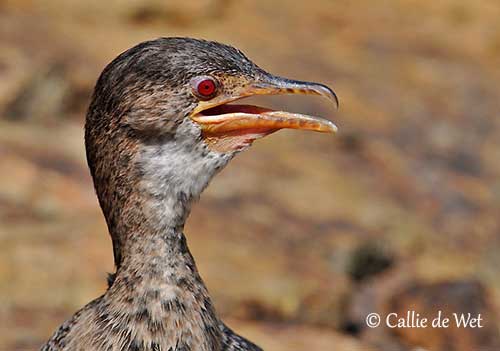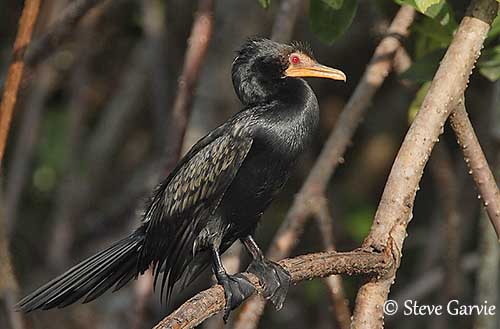
Fr: Cormoran africain
Ang: Reed Cormorant – Long-tailed Cormorant
All: Riedscharbe
Esp: Cormorán Africano
Ita: Cormorano africano
Nd: Afrikaanse Dwergaalscholver
Sd: Långstjärtad skarv
Photographers:
Steve Garvie
RAINBIRDER Photo galleries & Flickr Rainbirder
Callie de Wet
GALLERY
Text by Nicole Bouglouan
Sources:
HANDBOOK OF THE BIRDS OF THE WORLD vol 1 by Josep del Hoyo-Andrew Elliot-Jordi Sargatal - Lynx Edicions - ISBN: 8487334105
BIRDS OF AFRICA SOUTH OF THE SAHARA by Ian Sinclair and Peter Ryan - Princeton University Press Princeton and Oxford - ISBN: 0691118159
BIRDS OF THE GAMBIA AND SENEGAL by Clive Barlow and Tim Wacher – Helm Field guides – ISBN: 0713675497
BIRDS OF THE MIDDLE EAST by R.F. Porter, S. Christensen, P Schiermacker-Ansen C.Helm - ISBN: 0713670169
ROBERTS BIRDS OF SOUTH AFRICA by G. R. Mc Lachlan and R. Liversidge – The Trustees of the John Voelcker Bird Book Fund – ISBN: 0620031182
Biodiversity Explorer – The Web of Life in Southern Africa
Birds of Southern Africa (Tony Roocroft)
BIRDS of THE WORLD - An Online Bird Book
Wikipedia, the free encyclopaedia
Reed Cormorant or Long-tailed Cormorant
Microcarbo africanus
Suliformes Order – Phalacrocoracidae Family
INTRODUCTION:
The Reed Cormorant or Long-tailed Cormorant is a small, short-billed, long-tailed cormorant found in sub-Saharan Africa. There is a larger subspecies in Madagascar.
It frequents a wide variety of freshwater habitats except the fast-flowing streams. It feeds on aquatic preys caught by pursuing them underwater. It is monogamous and usually colonial breeder, often nesting with other waterbirds.
Mainly sedentary and partially migratory, this small cormorant is included in the genus Microcarbo with other small, long-tailed cormorants in the family Phalacrocoracidae.

DESCRIPTION OF THE BIRD:
Biometrics:
Length: 50-60 cm
Wingspan: 80-90 cm
Weight: 680 g
The Reed Cormorant adult in breeding plumage has glossy dark plumage with green gloss. The grey scapulars are slightly washed purplish-brown, and we can see a rounded, black terminal spot on each feather. On the upperwing, the wing-coverts are pale silvery grey with black shafts and fringes involving scaly/spotted pattern, and the greater coverts are tipped black. The long tail is blackish.
The underwing shows grey flight feathers and greater coverts, contrasting with black other coverts.
On the black glossy head, there is an erectile shaggy crest on the forecrown. During the breeding season, some white feathers separate the forecrown from the bare facial skin, and some longer filoplumes form a light tuft on the ear-coverts. They are rapidly lost. The bare facial skin is red to orange and finely spotted black.
The bill is horn/yellow with some dark brown markings on sides, whereas the culmen is dark grey. The eyes are red. Legs and large webbed feet are black.
Male and female are similar with the male slightly larger.
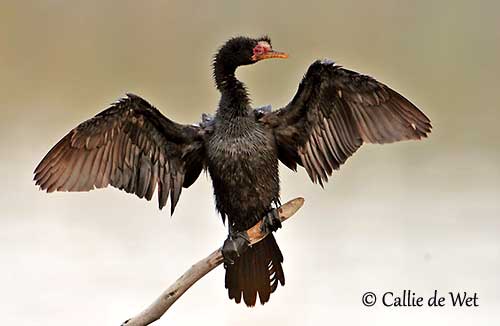
The Reed Cormorant adult in non-breeding plumage is blackish-brown with paler underparts. It lacks the crest on the forecrown and the green gloss on the head, and the bill is orange-red. The foreneck is often brown and mottled, with sometimes strong chestnut tinge on lower foreneck and breast. Flanks and thighs are blackish and contrast with the white to whitish-buff underparts.
The juvenile is dull dark brown above, scapulars and wings are more uniform or with blackish-brown fringes to feathers. The underparts are pale buffy with white throat. Foreneck and breast are washed brownish and flanks and thighs are dark.
The crest is usually lacking or much shorter. The eyes are grey at first and become brown soon. The facial skin is dull.
The immature resembles non-breeding adult but with less silvery-grey coverts. The underparts are whiter whereas head and neck to breast are darker.
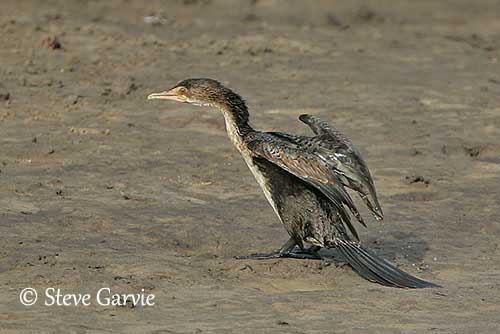
SUBSPECIES AND RANGE:
The Reed Cormorant has two subspecies.
M.a. africanus (described and displayed) occurs in sub-Saharan Africa, from Mauritania and Senegal, E to Sudan and Eritrea, and S to South Africa.
M.a. pictilis occurs in Madagascar. This race is larger than nominate, with bigger but less rounded spots on the upperparts.
HABITAT:
The Reed Cormorant frequents numerous freshwater habitats except the fast-flowing rivers. It is usually found in waterbodies with gently sloping shores, around lakes, along slow-moving streams and often far inland, but it also frequents sheltered coastal waters. It often colonizes temporary flooded areas, although during droughts, it remains on permanent waterbodies. It usually frequents waters bordered by vegetation and emergent trees for nesting.
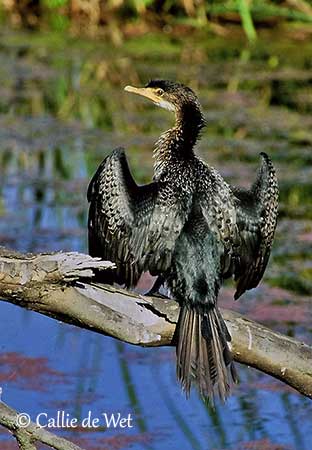
CALLS AND SONGS: SOUNDS BY XENO-CANTO
The Reed Cormorant is usually silent. However, while going to roost and at nest, it gives a hissing cackle. Some bleating chorus can be heard from the roost “a-a-a-a-a-a”.
BEHAVIOUR IN THE WILD:
The Reed Cormorant feeds primarily on fish of up to 20 centimetres in length, but it also takes frogs, molluscs, crabs, and insects too (dragonfly larvae and beetles of family Tenebrionidae).
Like other Phalacrocoracidae, it pursues the preys through the water and propels itself with the large webbed feet. It is able to stay underwater during about 40-45 seconds, and forages in shallow water, less than two metres in depth.

Outside breeding season, it can be found singly or in loose groups and small flocks. They return to communal roosts in larger flocks, and these evening flights are conspicuous over rivers or coastal mangroves.
During the breeding season, the Reed Cormorant is monogamous with long-term pair-bond. They often breed colonially with other bird species such as Western Cattle Egret, African Darter, Grey Heron and Black-headed Heron. The colonies may include between 10 and 50 pairs, sometimes more.
The nest-site is selected by the male. It displays to passing females by moving the head back and forth while flapping its wings. Both parents share all the nesting duties.
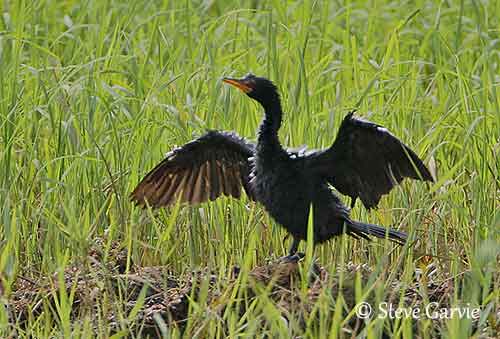
The Reed Cormorant is mainly resident and only performs irregular movements related to local water levels, involving local disappearances of the birds and temporary colonization of new wet areas.
The flight is powerful with regular, continuous wingbeats, sometimes interspersed with occasional glides.
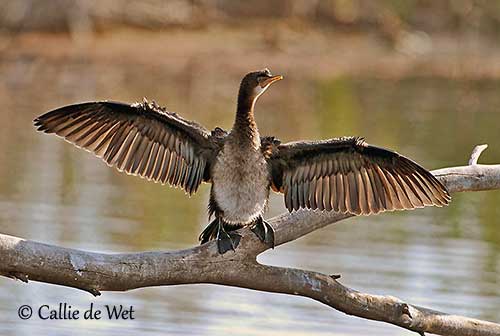
REPRODUCTION OF THIS SPECIES:
The breeding season varies according to the range, and the laying may occur in all months, but mostly between October and April in South Africa. Some colonies may gather very large numbers of pairs of several bird species.
The nest is often placed in tree fork over water, or in large reedbeds, and occasionally on the ground. It is built by both adults during one week. This is a thin, missy structure made with sticks or dead reeds, and lined with leaves and grass.
The female lays usually 3-4 elongated, pale eggs, and both adults incubate during 23-24 days. At hatching, the chicks are naked, but a black down grows quickly. They are fed by their parents and fledge 28-35 days after hatching. They are independent 4 weeks after fledging.
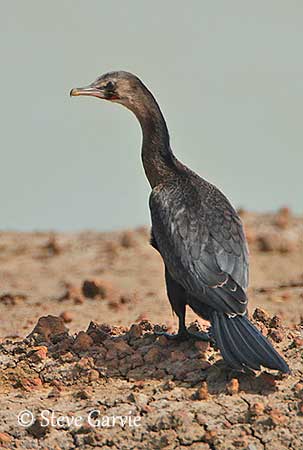
PROTECTION / THREATS / STATUS:
The Reed Cormorant has benefited from dam construction. It is common and widespread throughout most of the range. However, it is sometimes persecuted in Southern Africa because of its local, although insignificant, impact on fish stock. Disturbance at feeding areas by fishermen is increasing in Kenya.
Raptors such as African Fish-Eagle, Osprey and Tawny Eagle are their main predators.
The population trend is decreasing, but currently, the Reed Cormorant is evaluated as Least Concern.
